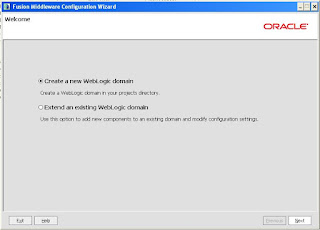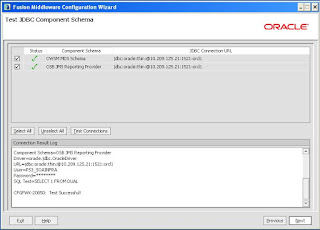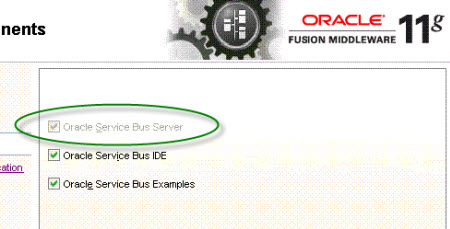Oracle Service Bus PS3(11.1.1.4) installation.
This blogpost is pertaining to OSB PS3(11.1.1.4) installation.
The post includes three parts: 1. Weblogic Server Installation 2. Oracle Service Bus 11.1.1.4 installation on top of Weblogic Server 3. Creating and Configuring a Weblogic Domain with Oracle Server Bus 11.1.1.4 aka PS3 product Weblogic Server Installation: Go through one of my previous blog post on installing WeblogicServer+Coherence+OEPE Oracle Service Bus 11.1.1.4 installation on top of Weblogic Server             We are done installing the OSB PS3 11.1.1.4 product !!! We will move on in order to create and configure a weblogic domain with OSB product !!!
Hope you are done with the Part#1 of the installation. We will move on to create and configure a weblogic OSB domain.
          We are done configuring the OSB domain. OSB 11g Installation Overview
. OSB (Oracle Service Bus) = ALSB(BEA’s AquaLogic Service Bus) + ESB (Enterprise Service Bus)
Key points for OSB 11g Installation 1) OSB Installer gives you option to install following sub components a) Oracle Service Bus Server b) Oracle Service Bus IDE (Integrated Development Environment) c) Oracle Service Bus examples (sample examples to see How OSB operates in run-time environment) - “Choose Custom Install to select this option” 2) Prerequisites software to install Oracle Service Bus 11g a) Oracle Database(OSB schema to store data and metadata) b) Repository Creation Utility (RCU) more here to create OSB related schema in Database c) Oracle WebLogic Server (OSB will run on WebLogic server) d) Optional : Oracle Coherence (optional component, recommended for caching functionality) - This comes with default installation of WebLogic Server e) Optional : Oracle Enterprise Pack for Eclipse (used mainly to develop, deploy and debug applications for weblogic server) : If you are using OSB IDE component then OEPE (Oracle Enterprise Pack for Eclipse) is mandatory - This component can also be installed with WebLogic Server 3) For development, WebLogic comes with default database (Derby) which can be used in place of Oracle Database (If you plan to use weblogic’s derby database then oracle database and RCU is not required) 4) Installation order for Oracle Service Bus 11g installation a) Install database 11g b) Install RCU c) Run RCU to create/load schemas for OSB d) Install OSB 11g e) Create/Extend domain by running config.sh 5) OSB 11g Installation type a) Interactive - installer (GUI) will prompts details to install software b) Silent - Installer runs on its own with no intervention from user. Installer uses response file (with parameters used during installation) to install software silently. 6) OSB 11g installation two options a) Typical Install - OSB Server and Binary of OSB IDE in new Oracle Home b) Custom Install - gives option to select components (OSB Server, OSB IDE, OSB Examples) 7) Default OSB 11g install will create ORACLE_HOME (directory Oracle_OSB1) under Fusion Middleware Home (MW_HOME). This directory Oracle_OSB1 is also referred as OSB_HOME or OSB ORACLE_HOME. For more information on MW_HOME, ORACLE_HOME and DOMAIN_HOME
Database Schema is NOT mandatory with OSB. Database is required only if you wish to use
a) Reporting Feature in OSB or b) Oracle Web Services Manager (OWSM) policies. 9. To start installation run a) For Unix- [software]/runInstaller -jreLoc $MW_HOME/jrockit_160_17_R28.0.0-670/jre b) For Windows- [software]\setup.exe -jreLoc $MW_HOME\jrockit_160_17_R28.0.0-670\jre 10.Fusion Middleware Home (MW_HOME) can contain one and only one Oracle Service BusORACLE_HOME . In one MW_HOME there could be multiple ORACLE_HOME of different type like one ORACLE_HOME for OSB, one for SOA and one for IdM (Identity Management) 11. OSB installation log files are stored in ORACLE_INVENTORY_LOCATION/logs directory 12. If you are installing OSB 11g on 64 bit machine, select Custom Installation type and deselect OSB IDE (Integrated Development Environment) option. 13. After OSB install, create domain ($MW_HOME/oracle_common/common/bin/config.sh|cmd). Default configuration will create domain with 1 Admin Server (listening on port 7001) and 1 Managed Server(osb_server1) . For more information on WebLogic Server Domain, Admin Server and Managed Server
14.After OSB installation and configuration, Start Admin Server and Doamin Server using startWebLogic.sh & startManagedWebLogic.sh(osb_server1) For more information on options to start WebLogic Server
15. Access OSB Administration Console using
http://<hostname>:<osb-port>/osbconsole where osb-port is port configured for managed server osb_server1 |
Friday, May 11, 2012
OSB Installation
########
Subscribe to:
Post Comments (Atom)

0 comments:
Post a Comment